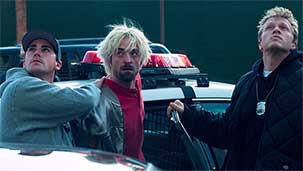There are so many ways music can be used in film making. Sometimes it is as a counterpoint to what’s happening on screen—like when a subtle piece of music underpins an otherwise frantic scene. Occasionally it’s diegetic: music that’s organically part of the film, a direct connection between the soundtrack and the narrative. It can also be used as an ironic commentary on a characters behaviour, or a way to lead the audience astray. But music is usually just one of many aspects of any movie going experience. Important, but not necessarily essential.
Then there are times when the music becomes a part of that experience in a much more fundamental way—so much so that if you removed the soundtrack, it would completely change the film.
One good example would be this summer’s Baby Driver. The whole movie is built around the music, diegetic or otherwise. Another example is your film, Good Time. The difference being, while Baby Driver is using music as a kind of organizing principal—each song is used as a template for an action set piece, determining the pace and composition—Good Time is a film where the soundtrack is all about atmosphere. Often piercing and dissonant, other times menacing and anxiety inducing, each piece of music is essential to how the directors, the Safdie brothers, want the audience to experience the scene. There isn’t much subtly involved, but that doesn’t necessarily undercut the effectiveness of the strategy.
Good Time feels as if it were a Cassavetes movie written by the Coen Brothers. It is equal parts a sleazy, intimate drama centred on an amateurish but moderately talented conman, and brutally frank commentary on the desperation inherent in living poor in urban America. The whole film is infused with a manic energy that feels low budget and edgy, but the technical aspects (cinematography, sound, lighting) are meticulously executed. Your soundtrack follows suit. It is often invasive and overt but still perfectly calibrated. You managed to successfully parallel the film’s visual aesthetic in a way that complimented what is often an unsettling experience.
What Good Time does very well is tell the story of a low rent conman, Connie Nikas, trying desperately to disentangle his mentally impaired brother, Nick (played with real delicacy by one of the directors, Benny Safdie), from some unpleasant legal problems. That those problems were the result of Connie’s botched robbery scheme is just one of the ways the Safdie’s play with the audience’s sympathies. We follow Connie throughout the film as he digs himself deeper and deeper into trouble of his own creation. And while we do hope for his success, if for no other reason than to see Nick released, his amoral manipulation of everyone who falls within his reach is often repellent.
Connie is an interesting character—an outrageous, if innately talented, liar. Driven by greed, envy, desperation, but also what seems to be a sincere love for his brother, he’s complicated, fascinating, even charming. He’s also short sighted, self-indulgent, and ultimately inept. Good Time succeeds as a depiction of a world that isn’t often portrayed with much precision or accuracy—that of the run of the mill loser. Criminals like Connie are, whatever their natural talents, often not very thoughtful. That fact, combined with a tendency to self-destructiveness and a lack of impulse control, lead them into circumstances that are both tragic and absurd. Good Time traces Connie’s tangle of bad decisions to an end that is weirdly satisfying, even while it is impossible to anticipate.
The soundtrack follows a similar path: loud, abrasive and often off-putting. It is nonetheless true to a film that is difficult to like but still manages to get under your skin. And that’s a pretty neat trick.
Sincerely,

Tim







